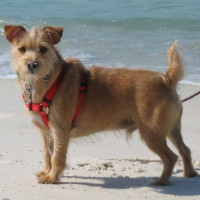Appearance of the Rustralian Terrier
|
| Extremely cute in appearance, with soft eyes and erect ears, he's almost irresistible as he passes. Small in stature but big on personality, these little dogs are well proportioned for their small, solidly muscled bodies, which are made for movement. Its short, elegant legs can move with surprising speed, and these little dogs can turn on a dime. The face features a pointed muzzle, small teeth that meet in a scissor-like pattern, and a shiny black nose. In typical Terrier style, their round, dark eyes have an inquisitive, curious expression, and their little tail can wag at the speed of light. Their coat is of medium length, often rough-textured and water-resistant. Colors can vary from the white and tan of the Jack Russell Terrier, to any combination of tan, brown, reddish-black and sandy markings. Although small in stature, they make up for their lack of height with personality and activity. |
Temperament of the Rustralian Terrier
|
| This little dog can best be described as an inexhaustible ball of energy, loving life and not wanting to miss a minute of it. Your Rustralian Terrier will follow you around the house, tease the cat and play with the kids at almost the same time. Make sure you socialize these little dynamos when they're young, so they mix well with other animals and children. The Terrier has a strong hunting instinct and, if it can get along with your cat it has known all its life, it can chase the neighbor's cat with unrepentant energy. These dogs are companion dogs, not to be left outside in a kennel. Although they're quite sturdy little Terriers, they won't appreciate being left alone - they want to be inside with you, ideally on your lap. They're intelligent dogs who respond well to training, but keep sessions short and fun to maintain their attention. Vary the training routine, but don't let it become boring, or he'll wander off ignoring you, much to your disgust. He's an alert little dog who doesn't miss a thing, and will warn you if a stranger encroaches on his territory. They adapt well to apartment living, but will still need a daily walk and plenty of play to expend their abundant energy. They also adapt well to a house with a garden, but make sure your garden is well fenced if you don't want to have to chase your little Terrier every time someone passes by. Life will never be dull with the Rustralian Terrier to entertain you. A bundle of bubbling energy, plenty of affection to share and a cheerful personality make them a prime candidate for a companion - if you can match their energy and enthusiasm. |
Needs and activities of the Rustralian Terrier
|
| Like most Terriers, the Rustralian Terrier is curious, active and full of life. He needs a daily walk to burn off energy, and will love free time at the dog park. These little dogs don't seem to realize how small they are, and will fearlessly take on a big dog, so make sure you keep a close eye on your tenacious terrier. He loves a variety of toys to destroy or throw, and will happily join in any family game, whether invited or not. The Rustralian Terrier will be delighted to accompany you on a walk, to explore the neighborhood and check out the terrain. Make sure he's on a leash, as he has a strong hunting instinct and is likely to go after a small, fast-moving animal. All your calls and pleas for him to come back will fall on deaf ears, so be warned. While they love to be active, they also love to snuggle up on your lap for some pampering and bonding. They're dogs that adapt best to an active family, which will bring out the best in them. |
Maintenance of the Rustralian Terrier
|
| The Rustralian Terrier is relatively easy to care for, needing only a good brushing twice a week to keep it tidy and tangle-free. His coat is water-resistant, so don't over-wash him, as he may develop skin problems due to the lack of natural oils. When bathing him, use a mild dog shampoo and rinse well. Dry him with a towel and keep him warm if you bathe him in winter. While you're grooming them, check for sores or cuts that could become infected. These very active little animals get into the tightest places and can end up injuring themselves because of their curiosity. From an early age, teach your Rustralian Terrier to enjoy having his teeth brushed to avoid any teething problems. Check his ears for infections and his eyes for tears or redness. Finally, gently clip his nails and let him go. He'll be so excited he'll circle the house twice before calming down. |









 English (United Kingdom)
English (United Kingdom)